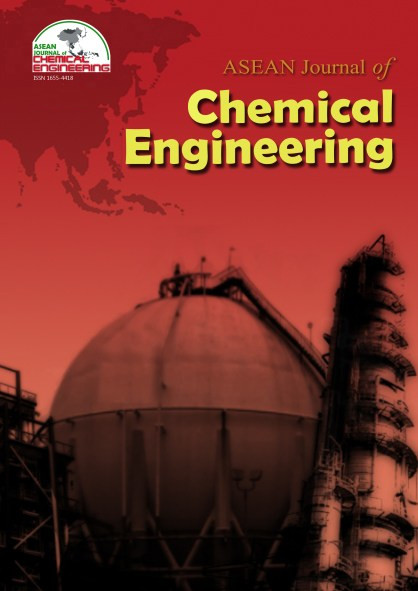Adsorption Compression Analysis for Supercritical Fluids using Ono-Kondo Model
Abstrak
In this paper, supercritical data has been evaluated and shown to demonstrate adsorption compression. Ono-Kondo analysis of adsorption isotherms for supercritical systems (including nitrogen, methane, and carbon dioxide on activated carbon Filtrasorb 400 and on zeolite 13X) indicates adsorption compression phenomenon at high pressure end just as in subcritical systems. Experimental isotherms for adsorption of supercritical fluids are plotted in Ono-Kondo coordinates with the Henry’s constant estimated based on results of modeling as well as calorimetric and chromatographic measurements. The linear sections of the results show the range of applicability of the classical Ono-Kondo model with constant energies of interactions. The slopes of these linear sections represent values and signs of these energies: negative slopes indicate repulsive interactions in adsorbed phase due to adsorption compression. Switching interactions from attractive to repulsive with an increase in the pressure for supercritical adsorption suggests that adsorbed phase has two regions. One is an attractive region at low-pressures and the other is a repulsive region at high pressures. It can be indicated that the shape of isotherms in Ono-Kondo coordinates can help to understand adsorbate-adsorbate energies; the slope of the line in Ono-Kondo coordinates gives the sign and magnitude of the energy as a function of adsorbate density.Referensi
1. S. Ono, and S. Kondo: Encyclopedia of Physics. 10 (1960) 134.
2. G. L. Aranovich, and M. D. Donohue: J. Colloid. Interface. Sci. 189 (1997) 101-108.
3. M. D. Donohue, and G. L. Aranovich: J. Colloid. Interface. Sci. 205 (1998) 121-130.
4. G. L. Aranovich, and M. D. Donohue: J. Colloid. Interface. Sci. 180 (1996) 537-541.
5. G. L. Aranovich, and M. D. Donohue: Langmuir 19 (2003) 2722-2735.
6. G. L. Aranovich, T. E. Wetzel, and M. D. Donohue: J. Phys. Chem. B 109 (2005) 10189-10193.
7. G. L. Aranovich, C. Sangwichien, and M. D. Donohue: J. Colloid. Interface. Sci. 227 (2000) 553-560.
8. G. L. Aranovich, and M. D. Donohue: Colloid and Surfaces A: Physicochemical and Engineering Aspects. 187-188 (2001) 95-108.
9. G. L. Aranovich, and M. D. Donohue: J. Colloid. Interface. Sci. 292 (2005) 202-209.
10. A.V. Kiselev: Intermolecular Interactions in Adsorption and Chromatography. (1986).
11. H. M. McNair, and E. J. Bonelli: Basic Gas Chromatography. (1968).
12. C. J. Cowper, and A. J. DeRose: The Analysis of Gases by Chromatography. (1983).
13. M. Sudibandriyo, Z. Pan, J. E. Fitzgerald, R. L. Robinson, and K. A. M. Gasem: Langmuir 19 (2003) 5323-5331.
14. S. Cavenati, C. A. Grande, and A. E. Rodrigues: J. Chem. Eng. Data. 49 (2004) 1095-1101.
2. G. L. Aranovich, and M. D. Donohue: J. Colloid. Interface. Sci. 189 (1997) 101-108.
3. M. D. Donohue, and G. L. Aranovich: J. Colloid. Interface. Sci. 205 (1998) 121-130.
4. G. L. Aranovich, and M. D. Donohue: J. Colloid. Interface. Sci. 180 (1996) 537-541.
5. G. L. Aranovich, and M. D. Donohue: Langmuir 19 (2003) 2722-2735.
6. G. L. Aranovich, T. E. Wetzel, and M. D. Donohue: J. Phys. Chem. B 109 (2005) 10189-10193.
7. G. L. Aranovich, C. Sangwichien, and M. D. Donohue: J. Colloid. Interface. Sci. 227 (2000) 553-560.
8. G. L. Aranovich, and M. D. Donohue: Colloid and Surfaces A: Physicochemical and Engineering Aspects. 187-188 (2001) 95-108.
9. G. L. Aranovich, and M. D. Donohue: J. Colloid. Interface. Sci. 292 (2005) 202-209.
10. A.V. Kiselev: Intermolecular Interactions in Adsorption and Chromatography. (1986).
11. H. M. McNair, and E. J. Bonelli: Basic Gas Chromatography. (1968).
12. C. J. Cowper, and A. J. DeRose: The Analysis of Gases by Chromatography. (1983).
13. M. Sudibandriyo, Z. Pan, J. E. Fitzgerald, R. L. Robinson, and K. A. M. Gasem: Langmuir 19 (2003) 5323-5331.
14. S. Cavenati, C. A. Grande, and A. E. Rodrigues: J. Chem. Eng. Data. 49 (2004) 1095-1101.
Diterbitkan
2011-12-31
Bagaimana cara mengutip
Sumanatrakul, P., Sangwichien, C., Aranovich, G., & Donohue, M. D. (2011). Adsorption Compression Analysis for Supercritical Fluids using Ono-Kondo Model, 11(2), 45-52. Diambil dari https://jurnal.ugm.ac.id/v3/AJChE/article/view/8090
Terbitan
Bagian
Articles


